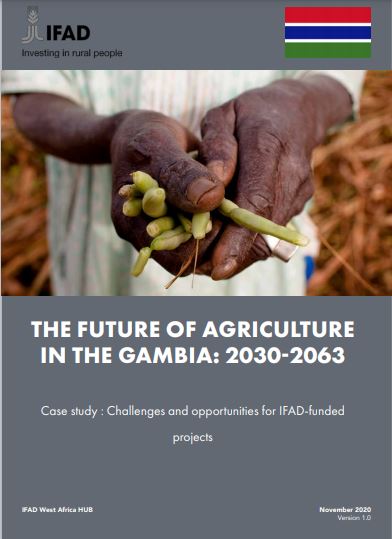The future of agriculture in the Gambia: 2030 – 2063

ABSTRACT
Agriculture is a key sector of the Gambian economy and contributes to 17% of GDP and 30-40% of export earnings. It employs almost half (46%) of the workforce and is the source of income for 80% of the rural population. Economic performance is improving, without translating into a reduction in poverty, which remains widespread and deep, with a national poverty rate of 49 %, and mainly rural (69% of rural poverty).
Food security is undermined by structural problems, such as irregular rainfall, which leads to a decrease in agricultural production and affects the availability and accessibility of food. As national production covers only 50% of the country’s food needs, The Gambia is dependent on imports. More than half of the Gambian population is food insecure.
Projections show that food needs will evolve towards greater diversity, reflecting a more balanced diet, from an energy, food and nutritional point of view, even if the price of food will continue to play a role in the type of food consumed. However, the evolution of needs and projections in areas and production seems beyond the reach of the current capacity of the agricultural sector in The Gambia.
The agricultural sector faces three major challenges: i) a food challenge, in a context of growth in demand linked
to demographic dynamics; ii) a socio-economic challenge, where the persistence of poverty necessitates job creation and added value; and iii) an environmental challenge, given the increasing pressure on fragile natural resources. These challenges require the development of all production, processing and distribution sectors to support food (human and animal), agri-food industries and exports.
To cope with these challenges and in order to catch up and continue previous achievements, The Gambia has no other choice but to invest in well-identified areas, namely : i) mobilize surface and groundwater resources available through irrigation infrastructure; ii) increase production yields based on improved agricultural technologies and practices adapted to multiple constraints; iii) develop priority agri-food value chains based on rice, corn and horticulture, and on short cycle animal breeding (poultry and small ruminants).
The value chains thus developed generate rural and urban jobs, promote strong and inclusive growth, provide greater opportunities to agricultural producers and other private entrepreneurs, sustainably lift the most vulnerable out of poverty and insecurity and strengthen their resilience. All of these initiatives are supported by the improvement of infrastructure in access, agricultural and livestock markets, the development of the supply and distribution market for agricultural and veterinary inputs and equipment, the strengthening of the financing system for the agricultural sector, the capacities of producers, the private sector, agricultural services and agricultural research, as well as mechanisms for the prevention and management of food crisis. The simulations carried out show that in 2024 all of these initiatives can allow a cumulative annual growth in the value of gross agricultural production of more than 14% and around 6% of GDP growth.